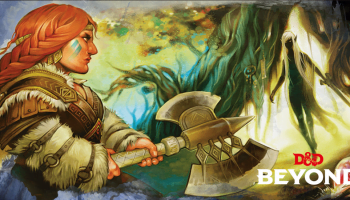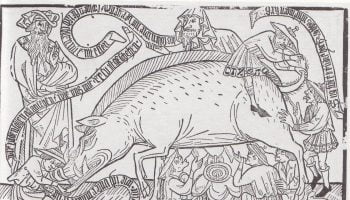Part XXXII in our ongoing series on Race, Racism and the Middle Ages, by Robert Chazan. You can find the rest of the special series here.
If you are interested in learning more, Prof. Chazan expands on these ideas in his 2010 book Reassessing Jewish Life in Medieval Europe.
The term “medieval,” when used in contemporary parlance, tends to be synonymous with “cruel and barbarous,” conjuring up imagery of religiously grounded hatred, persecution, and bloodshed. The Jews of medieval Christian Europe are often referenced as one of the central reasons why the period is projected this way: they purportedly suffered at the hands of Christian warriors during the crusades, Christian churchmen during the inquisition, and Christian rulers who confiscated their property and expelled them.
This vision of the Middle Ages in general, and of Jewish fate in particular, is the legacy of Enlightenment thinkers’ backlash against medieval European civilization. Like all such backlashes, this one is a combination of truth and fiction, and an oversimplification of a complex subject. This is the case for generalizations about medieval civilization overall as well as about the Jews in particular. In reality, neither medieval society, nor Jewish life within it, was always dire; there were many times and places in which medieval Jewish people and Jewish culture thrived.
A Balanced View of Jewish Life in the Middle Ages
A more-balanced perspective on the treatment of Jews during the Middle Ages must begin with a simple, but important awareness: The medieval world was much more than the Roman Catholic sectors of Europe. This is true both geographically and religiously.
The medieval period is generally defined as extending from roughly 500 to roughly 1500 (although some scholars now extend the Middle Ages down to the end of the eighteenth century, the point in time when Enlightenment ideals of social equality began to be actualized in the creation of new-style polities and societies). Over this period of a millennium or more, Jewish societies extended from Mesopotamia westward across Europe and North Africa. During the central centuries of the Middle Ages (roughly the ninth through twelfth centuries), the largest expanse of this vast area was ruled in the name of Islam; other sectors were ruled in the name of Greek Christianity; the smallest and weakest segment of this vast territory was ruled in the name of Roman Catholicism.
The Enlightenment’s rejection of medieval civilization took place in the Roman Catholic sectors of Europe. As a result, it reflected the realities of that area during the closing centuries of the Middle Ages. By that time, these territories had overcome their earlier weakness, had achieved leadership in the world, and had come to harbor the largest portion of worldwide Jewry. But the concentration of Jews in Roman Catholic Europe toward the end of the Middle Ages (to which we shall return) was by no means the norm throughout the medieval period. Jewish population distribution during the earlier centuries of the Middle Ages was quite different.

During the central period of the Middle Ages (c. 800–c. 1100) the vast majority of worldwide Jewry was found in the Islamic lands, which stretched from Mesopotamia westward across the eastern, southern, and western shores of the Mediterranean. The dominant Jewish community at the time was in Mesopotamia—it had a large Jewish population, a flourishing Jewish economy, and a vigorous Jewish intellectual life. The Jewish community in Palestine—once the center of the Jewish world but by then considerably reduced—was also part of the realm of Islam. But newer Jewish communities also sprang up across the southern and western shores of the Mediterranean Sea.
Medieval Jewish Life under Muslim Rule

If “medieval” implies cruel and barbarous, then Jewish circumstances under Islamic rule were by no means medieval. Let us begin on the doctrinal level. The Islamic perspective on humanity divided the peoples of the world broadly into three groups: the realm of idolatry (defined as completely erroneous); the peoples of the book (namely Jews and Christians), who were viewed as the bearers of genuine, albeit incomplete, divine truth; and Islam, the final and full revelation of divine truth.
This was hardly a message of human equality; Islam was understood as the full truth and Muslims as the privileged bearers of that truth. Nonetheless, other monotheists—which meant, essentially, Jews and Christians—were honored for their reception of a significant level of divine truth. This translated into an Islamic policy of full protection of these alternative monotheisms and monotheists. Jews and Christians as private individuals were not to be persecuted for their beliefs and practices. The corporate institutions of Jews and Christians were likewise to be respected and protected.
Beyond this Islamic theory, there were social realities that positively affected Jewish life throughout the realm of Islam. In the first place, Jews were long-time residents of these vast areas. Their presence long predated the emergence of Islam—and indeed the emergence of Christianity as well. These Jewish inhabitants of Islamic territories were viewed by others and by themselves as simply a given part of the terrain. Moreover, the population of the Islamic realm was highly diverse racially, ethnically, and religiously. The relatively small Jewish minority was thus in no sense conspicuous. Indeed, of the two respected monotheisms, the Jews tended to be favored by the Muslim ruling class. In many areas (for example Spain and Italy), Christians had been in power, but had lost their power to Muslim conquerors. Thus, the local Christians were inherently suspected of harboring anti-Muslim aspirations. Nowhere was this true for Jews, who were generally deemed cooperative and trustworthy.
Thus the Jews of the realm of Islam in its heyday (c. 800–c. 1100) were by no means regular victims of mob violence, religious persecution, or exploitation by the ruling class. The Jews of the Islamic sphere grew in numbers, flourished economically, interacted vigorously with their creative non-Jewish milieu, fashioned major institutions of Jewish intellectual and spiritual activity, and produced great intellectual and spiritual leaders and works. These were aspects of Jewish life and achievement unknown to the Enlightenment thinkers for whom the Middle Ages as they knew it—i.e. medieval Roman Catholic Europe—constituted a period of unrelieved religious bigotry and a set of Jewish experiences that exemplified, and indeed highlighted, such bigotry.
The Rise of Catholic Europe and its Jews
Toward the end of the first millennium, a process of slow change began, which would result in a massive redistribution of power throughout the medieval world. Roman Catholic Europe—until then the weakest of the sectors of the medieval world—slowly began to develop in ways that would eventually transform it into the most powerful area on the scene.

This slow but steady change involved, above all else, the maturation of northern Europe from a relatively backward hinterland into the dynamic center of medieval life and civilization. Arable lands in the north were extended; populations grew; cities expanded; trade and commerce matured; governance became increasingly effective; security improved; the Church became better organized; cultural institutions and creativity flourished. By the end of the fifteenth century, Roman Catholic Europe led the way in the discovery and exploitation of far-off areas of the globe, which served to enhance even further its newfound dominance. This dominance lasted well into modernity.
These changes had enormous implications for Jewish history. Up through the end of the first millennium, the Jewish population of Roman Catholic Europe was miniscule. There were minor Jewish enclaves across southern Europe—in northern Spain, southern France, and Italy. But there were hardly any Jews across backward northern Europe. But as Roman Catholic Europe surged, its Jewish population began to grow.
In part, this Jewish population growth was the result of accelerating Christian conquests of Muslim territories, especially on the Iberian peninsula. As the Christian re-conquest of Spain proceeded from north to south, towns with large Jewish communities were added to Christendom. The conquering Christian rulers were keen to keep these Jews in place rather than have them flee to other Muslim-controlled lands, in order to preserve the advanced level of their economies. Slowly, Jews from areas of the Mediterranean Basin that remained under Muslim control were attracted by the burgeoning opportunities in the southern areas of an expanded and vitalized Roman Catholic Europe, and so they migrated.
From the perspective of Jewish history, the truly monumental change involved northern Europe. An area that had never been home to a significant Jewish population slowly began to attract Jews from the southern lands. Only those Jews with the mobility provided by business and trade could make the move; these Jewish immigrants were strongly supported by the northern political authorities, who were anxious to bring to their domains new settlers that could introduce the more advanced economic techniques of the older and better-developed south.
A New Branch of the Jewish People

France, late 14th century, MS. Bodl. 251, 49v. http://bodleian.thejewishmuseum.org/?page_id=149
Slowly and fitfully, a new branch of the Jewish people was created across northern Europe. This new branch of world Jewry (now called Ashkenazi Jews) eventually became the majority world Jewish population and created new patterns of Jewish material and spiritual life. This was the group that also saw the emergence of new forms of anti-Jewish thinking and behavior. The roots of the medieval anti-Jewish animus and persecution highlighted in Enlightenment rejection of the European Middle Ages lie in the origins and evolution of northern European Jewry during the High and Late Middle Ages.
The successful migration of Jews northward was fully supported by the political authorities, who were eager to utilize the Jewish economic skills and knowledge gained in the more-advanced southern sectors of Europe. The Church maintained what was, by that time, a well-established policy: Church leaders insisted on the rights of Jews to live securely and peacefully in Christian society. They equally insisted on limiting any Jewish behaviors that they thought might impinge on Christians.
Despite the eagerness of the local rulers and official support of the Church, the populace of northern Europe resisted these Jewish newcomers for a number of reasons. The most prominent was the common human antipathy toward recent immigrants—a lamentable phenomenon observable in all human societies at all times. Exacerbating this normal tendency, Christian Europe was—unlike the realm of Islam—relatively homogenous religiously. Thus, those who saw themselves as the indigenous inhabitants of northern Europe viewed the new Jewish settlers as a religious disruption. These grounds of opposition activated a dormant prejudice: the negative portrayal of Jesus’ Jewish contemporaries and their purported responsibility for his crucifixion. The consequence of all this was the emergence of significant hostility towards the new Jewish settlers in the north by many of their neighbors.
As a result of the popular resistance in northern Europe, the new Jewish settlers were not able to create for themselves diversified economic outlets. Most of them had come with skills in business and trade. As the Church attempted during the twelfth century to prohibit Christians from taking interest on loans from other Christians—which it saw as the sin of usury—it opened the way for these Jewish businesspeople, who were not governed by the prohibition of taking interest from Christian borrowers, to specialize in moneylending.
Once again, the rulers of northern Europe were supportive. The rapid economic development of their domains required an ongoing smooth flow of capital, and they themselves found that borrowing money was often useful. But, once again, this created a potent source of popular animosity. Moneylenders—like newcomers—are never popular. Out of the combination of multi-faceted discontents with the new Jews of northern Europe emerged a series of slanders, prejudices, and hatreds that plagued Jewish life from the twelfth century until today.
Medieval Anti-Jewish Violence
As a result of the complex circumstances described, Jews did suffer deeply in medieval Roman Catholic Christendom during the latter centuries of the Middle Ages. Religious difference was surely a factor in this suffering. But there were—as we have seen—other and more complicated factors as well. Some of the Enlightenment imagery of Jewish suffering is accurate; some is not. Jews were attacked by Christian crusaders. But the anti-Jewish violence associated with crusading, as examined in previous articles in this series, was fairly limited in scope. Moreover, such violence was soundly repudiated by the ecclesiastical authorities that created and provided spiritual guidance for crusading. The impact of the inquisition on Europe’s Jews was similarly limited. In fact, the inquisition had no direct jurisdiction over Jews; it was a court system designed to eradicate heresy from Christian society, not Judaism. Since a major form of heresy involved formerly Jewish Christians suspected of returning to their prior Jewish faith, the inquisitorial courts often dealt with Jewish thinking and behaviors on the part of Christian defendants. But these defendants were formally defined as Christians. Fully professing Jews rarely appeared before the inquisition. [ed. note: The question of these converts to Christianity (“Conversos,” in Spanish), is complex, not least because many had been forced to convert under threat of violence. We hope to address the complexities of their lives, violence in medieval Spain, and the inquisition more fully in a subsequent article.]
The most harmful suffering of Jews in Roman Catholic Christendom during the Middle Ages involved, first of all, the popular antipathy that arose as Jews migrated northward into new territory. This anti-Jewish hostility did not abate over the course of the medieval centuries; instead, it intensified markedly.
As a result, at points of intense stress, Jews became the scapegoats for broader societal malaise. During the mid-fourteenth century, for example, the world was suddenly struck by the devastating bubonic plague. As a result, many European Christians—utterly disoriented and terrified by the natural calamity—attacked Jews as the alleged source of the catastrophe. Similarly, during the late fourteenth century, when societal dislocation erupted throughout Spain, Jews again suffered popular violence. The same happened again in seventeenth-century Poland.
This popular anti-Jewish animus created a need for special support of the Jews on the part of the ruling class. Such supportive relations were characteristic of feudal Europe altogether, but Jewish dependence on Europe’s rulers was especially profound. During the early centuries of the second millennium, most of the northern-European political authorities provided the requisite support. Without that support, successful Jewish settlement could never have taken place. By the late twelfth century, however, the crucial support from the ruling classes became less certain. As the economy matured, the Jewish contribution to it became less crucial; rulers could weigh the advantages of expelling their Jews—which would provide economic resources through confiscation of Jewish property, ecclesiastical approval, and popular approbation. Expulsion of Jews from the more-advanced northwestern areas of Europe led the way to a new societal development destined for a long history—the expulsion of entire Jewish communities from European states.
A Balanced View of the European Jewish Experience
While some of the traditional targets of Enlightenment criticism of medieval European mistreatment of Jews—for example crusading and inquisition—are somewhat overblown, others—e.g. broad societal hostility, occasional eruption of widespread violence, and the novel phenomenon of group expulsion—are not. Looking at the overall history of the new, exposed, and often persecuted Jewry of northern Europe, however, one final observation is appropriate. Despite all the negativity in their circumstances, the northern-European Jews did proceed from the humblest of beginnings to become the largest branch of the Jewish people. In terms of their numbers, Northern-European Jewry reached parity with the older Jewries of the south by the early-modern centuries; subsequently they came to surpass decisively these older Jewries. Clearly, the negative aspects of Jewish experience in medieval Roman Catholic Europe, especially its northern sectors, were balanced by the stimulation provided by the rapidly developing and vigorous societies of Roman Catholic Europe.
If you enjoyed that article, please share it with your history-loving friends on Facebook, or on Twitter! And click to subscribe here to receive every new article from The Public Medievalist the moment it launches.




